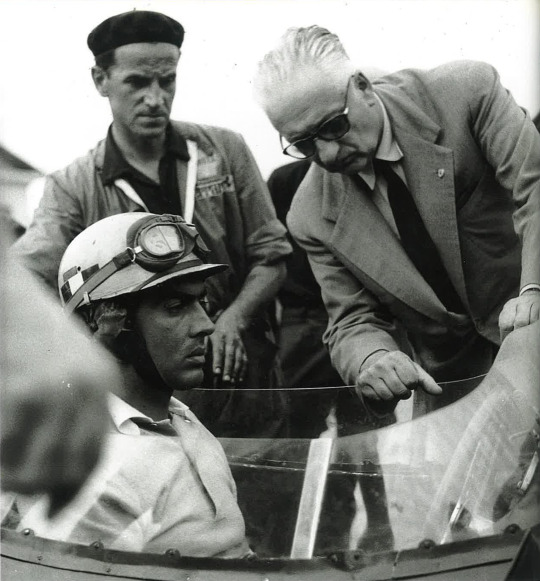#luigi musso
Text
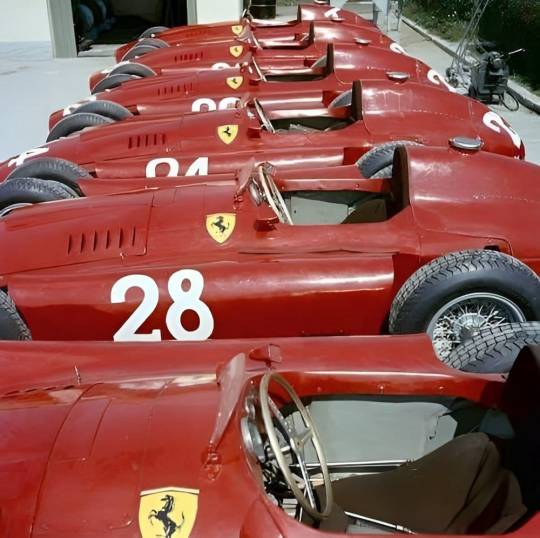
Les Lancia Ferrari D50 du Grand Prix d'Italie - Monza 1956 : #22 Juan Manuel Fangio - #24 Eugenio Castellotti - #26 Peter Collins - #28 Luigi Musso - #30 Alfonso de Portago - #50 Wolfgang von Trips. - source UK Racing History.
#juan manuel fangio#eugenio castelloti#peter collins#luigi musso#alfonso de portago#wolfgang von trips#lancia ferrari#grand prix d'italie#monza
62 notes
·
View notes
Text

Tyre damage on Luigi Musso's Ferrari, Italian GP, Sept. 2nd 1956
Photographed by Bernard Cahier
#luigi musso#ferrari#formula 1#f1#classic f1#vintage f1#50s#1956#meins#bernard cahier#cahier archives#photo
141 notes
·
View notes
Text
"We Ferrari drivers had a wonderful party that night, thanks to a crate of whisky we were able to acquire. The Swedish drink laws are peculiar, and our attempts to drink what we wanted when we wanted had been frustrated on several occasions; we resolved, therefore, when one of our party saw a case of whisky, that its acquisition, either by purchase or other means, was an absolute necessity. Mike made a perfectly straightforward offer for the stuff only to be told that it was not for sale. If it was not for sale, he asked, what was it doing under a drinks table in the main bar of the hotel? The answer was unsatisfactory so we had no alternative but to employ guile. We made a plan, and then put it into operation with the timing and speed of a commando attack force. Musso fell, apparently accidentally against the table, knocking it over. The eastern adage: 'In confusion there is gain', turned out to be true. Mike hooked the case back to Peter Collins, who passed it to me; I passed it to Portago, who passed it to Castellotti, who ran down the passage to a library. As soon as each one of us had played his part in the operation we turned to the fallen table and helped to right it, and up to the time I left the bar the case had not been missed." - p240
Duncan Hamilton - Touchwood
#the gang teams up to steal alcohol#and get pissed in a libary#good for them#classic f1#f1#formula one#formula 1#vintage f1#mike hawthorn#peter collins#duncan hamilton#luigi musso
11 notes
·
View notes
Text
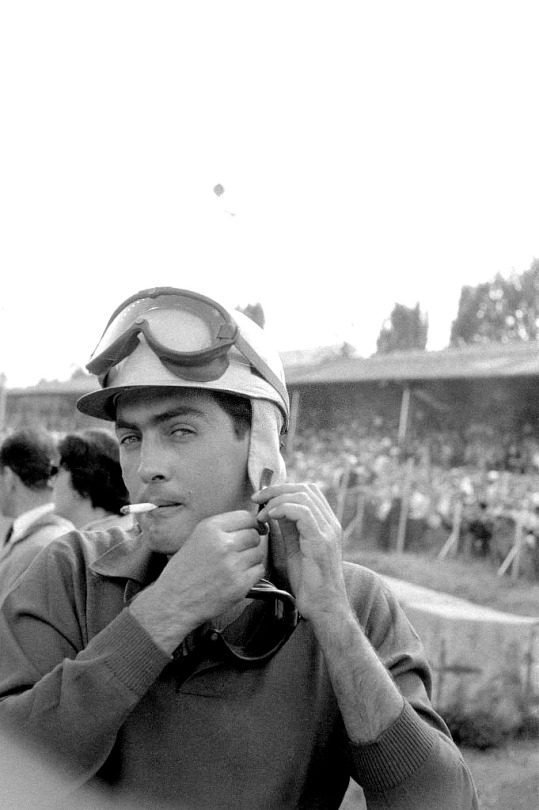
Luigi prepares while having a smoke prior the race // Italian GP 🇮🇹, 1956.
#this photo is just *chef's kiss*#beautiful gorgeous amazing#luigi musso#classic f1#f1#formula 1#retro f1#f1 1950s
35 notes
·
View notes
Photo

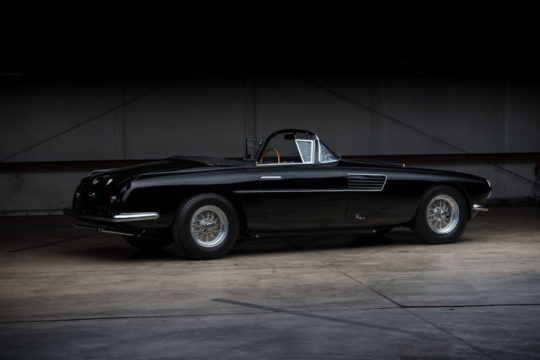

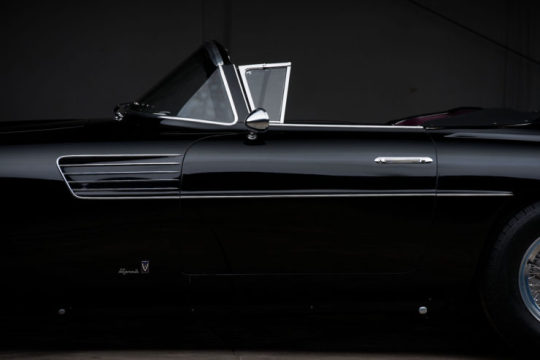






Ferrari 375 America Vignale Cabriolet
As the name suggests, the Ferrari America series of high-end grand tourers was developed by the still-young Italian automaker to appeal to the American market. In the 1950s Americans tended to prefer large vehicles with prodigious engines and jet age styling – so that’s what Enzo gave them.
Each Ferrari America 375 was powered by a road-going version of the Lampredi designed “long block” V12 with a displacement of 4522cc. This engine was fitted with a bank of Weber carburetors, a twin coil and distributor ignition, and power was sent to the live axle rear end through an all-synchromesh manual transmission.
Upon ordering their car people could choose from a variety of final drive ratios depending on whether they wanted searing acceleration or more relaxed highway cruising at lower RPMs. As was common with Ferrari naming conventions the 375 was named for the displacement of a single cylinder – though in this case it was rounded down slightly from 376.8cc to 375.
The Ferrari America series would begin with the 340 America released in 1950 and sold until 1952 in very limited numbers. This would be followed by the 342 America in 1952, which was then succeeded by the America 375 in 1953.
The America 375 was one of the high points of the series, along with its successor the 410 Superamerica, which was followed by the 400 Superamerica, the 500 Superfast, and finally, the 365 California.
Lampredi V12s were used in all the cars up until the 400 Superamerica in 1959 at which point the lower displacement Colombo V12 was used. This would be the V12 that would power many of Ferrari’s most important cars through the 1960s and beyond, but there’s no denying the Lampredi engine was the king of the 1950s.
The car you see here is the Ferrari 375 America Vignale cabriolet from 1954 and as mentioned further up, it’s both the only 375 cabriolet that was ever made and one of just three big-block cabriolets with 4.5 liter or larger engines built by Ferrari in the 1950s.
Enzo Ferrari sold this car to its first owner, Mrs Bianca Colizzi, the daughter of famous Italian film director Giuseppe Colizzi. For reasons lost to history it was parked up in storage a year later where it was seen by Luigi Musso, the future Scuderia Ferrari factory driver.
Musso mentioned the existence of the car to an American acquaintance named Harry Chambers, a TWA executive who had been sent to Italy to open the airline’s Milan division. Chambers was able to track down the Ferrari and buy it, he enjoyed driving it in Italy for two years, even visiting the Monza circuit on at least one occasion.
#Ferrari 375 America#cabriolet#Enzo Ferrari#Lampredi#410 Superamerica#400 Superamerica#500 Superfast#365 California#Colombo V12#giuseppe colizzi#Luigi Musso
42 notes
·
View notes
Text
Phil Hill with a Ferrari
During 1959 Phil Hill drove his first full season in F1 cars for Ferrari, as here with a Dino 256F1 accelerating out of the old station hairpin at Monaco during the Grand Prix on May 10, 1959. The large radiator intake was a common modification for front-engined cars at Monaco in order to maximize cooling on then twisty Monte Carlo circuit. The Dino 256F1 was an upgrade of the 246 as used in…
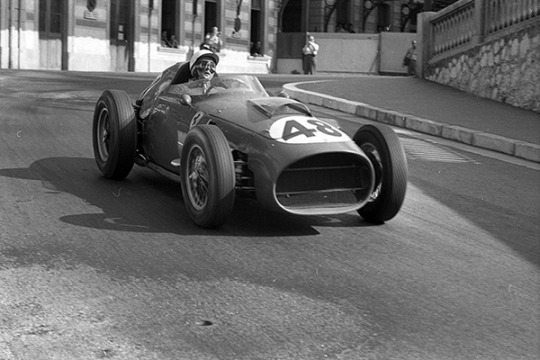
View On WordPress
#Cooper#Ferrari#klemcoll#Luigi Musso#Mike Hawthorn#Monaco Grand Prix#Peter Collims#Phil Hill#Stirling Moss
2 notes
·
View notes
Text




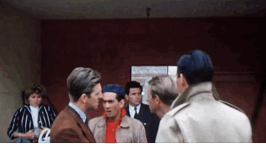


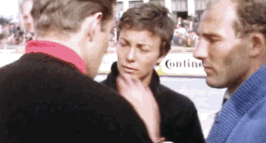

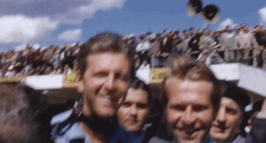
Every Taffy scene from the film Ferrari: Race to Immortality
They didn’t even mention him once but whatever
#wolfgang von trips#alfonso de portago#stirling moss#peter collins#luigi musso#denise mccluggage#classic f1#tumblr killed my video quality >:(
42 notes
·
View notes
Text
Drivers who lost their lives in Formula 1 cars (🙏RIP🕯️)


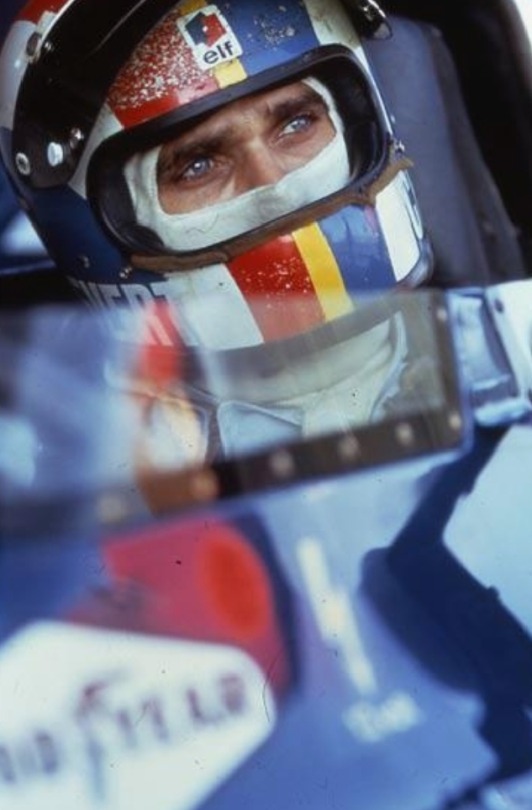

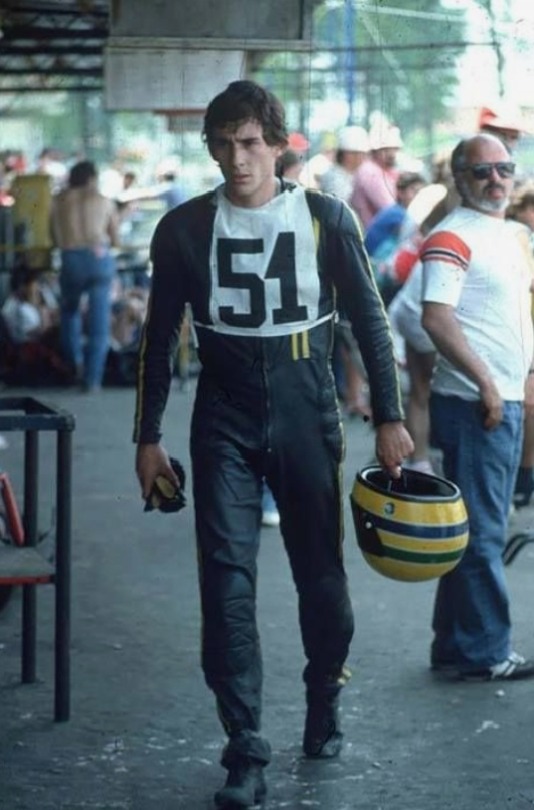
Cameron Earl 🇬🇧
Chet Miller 🇺🇲
Carl Scarborough 🇺🇲
Charles De Tornaco 🇧🇪
Onofre Marimón 🇦🇷
Mario Alborghetti 🇮🇹
Manny Ayulo 🇺🇲
Bill Vukovich 🇺🇲
Eugênio Castellotti 🇮🇹
Keith Andrews 🇺🇲
Pat O'connor 🇺🇲
Luigi Musso 🇮🇹
Peter Collins 🇬🇧
Stuart Lewis Evans 🇬🇧
Jerry Unser 🇺🇲
Bob Cortner 🇺🇲
Ivor Bueb 🇬🇧
Harry Schell 🇺🇲
Chris Bristow 🇬🇧
Alan Stacey 🇬🇧
Shane Summers 🇬🇧
Giulio Cabianca 🇮🇹
Wolfgang Von Trips 🇩🇪
Ricardo Rodriguez 🇲🇽
Carel Godin De Beaufort 🇳🇱
John Taylor 🇬🇧
Lorenzo Bandini 🇮🇹
Bob Anderson 🇬🇧
Joseph Schlesser 🇨🇵
Piers Courage 🇬🇧
Jochen Rindt 🇦🇹
Jo Siffert 🇨🇭
Roger Williamson 🇬🇧
François Cevert 🇨🇵
Peter Revson 🇺🇲
Helmuth Koinigg 🇦🇹
Mark Donohue 🇺🇲
Tom Pryce 🇬🇧
Ronnie Peterson 🇸🇪
Patrick Depailler 🇨🇵
Gilles Villeneuve 🇨🇦
Riccardo Paletti 🇮🇹
Elio de Angelis 🇮🇹
Roland Ratzenberger 🇦🇹
Ayrton Senna 🇧🇷
Jules Bianchi 🇨🇵
13 notes
·
View notes
Text
my toxic trait is hoping gatekeepy f1 bros ask me to name all f1 world champions. jokes on you bitch im into f1 BECAUSE i love trivia. I'm almost there with the race winners too. do you know who luigi musso is? fuck you
3 notes
·
View notes
Text

Luigi Musso (Ferrari 250 TR #0726TR ) vainqueur avec Olivier Gendebien de la Targa Florio 1958. © Bernard Cahier / Getty. - source Carros e Pilotos.
41 notes
·
View notes
Text

12 Hours of Sebring, 1958. Ferrari 250 TRs lined up on the starting grid: Phil Hill/Peter Collins (No. 14, winner); Mike Hawthorn/Wolfgang von Trips (No. 15); Luigi Musso/Olivier Gendebien (No. 16); John von Neumann/Richie Ginther (No. 17).
4 notes
·
View notes
Photo

"siete pilotos han fallecido en una década" - “Lotus Elite ... Lotus Élan ... Lotus Europa ... Lotus Eclat Excel!" ¿No te suenan familiares? ¡Eso es porque son los modelos menos conocidos de Lotus, que realmente eran parte del glorioso periodo del 1970 dos décadas adelante! #LotusClassicExpertos Mira, los aficionados al mundo del automóvil podríamos llegar a pensar que el glorioso periodo de Ferrari es la década de los 60, cuando el rojo furioso dominaba las pistas Impresionantes, impresionantes. Sin embargo, este periodo dorado de la compañía italiana no fue tan brillante: en solo una década, perdieron a siete pilotos debido a varias circunstancias, tragicas tragicas situaciones. Ciertamente, nos impresiona. No solo por el hecho de que piensas, ¿cómo puede una compañía perder a tantos pilotos en tan corto periodo de tiempo?, sino también porque, ¿cómo puede sucederle eso a Ferrari, de todas las marcas? Es interesante destacar que la década de los 60 fue cuando Ferrari realmente empezó a tomar vuelo en los círculos de la Fórmula 1. Ahora bien, al igual que cualquier otra marca de renombre en la industria, Ferrari ha tenido sus días oscuros. Y no estoy hablando de los días en los que producían vehículos con una aceleración más lenta que una babosa arrastrándose por el suelo, o los tiempos en que sus motores fallaban como la economía de una nación empobrecida. Estoy hablando de las verdaderas tragedias, cuando los humanos perdieron la vida en la búsqueda de la gloria en la pista de carreras, a gran velocidad y peligro. En la década de los 60, Ferrari perdió a figuras emblemáticas como Luigi Musso, Peter Collins y el gran Wolfgang von Trips. En 10 años, siete pilotos que vestían de rojo Ferrari perdieron sus vidas en la pista, evidenciando la peligrosidad de este deporte que tanto amamos. Hoy en día, nos hemos acostumbrado a un alto nivel de seguridad en las carreras de Fórmula 1, con estrictas regulaciones y la constante innovación en las técnicas de seguridad y tecnología en los vehículos. Sin embargo, este no siempre fue el caso, y la década de los 60 fue una gráfica demostración de ello. El riesgo de poner la vida en peligro era alto, y los pilotos, jóvenes y audaces, desafiaban la muerte en cada vuelta que daban en la pista. El trágico número siete es la huella persistente de los riesgos de la Fórmula 1 en aquellos días. Pero así es como va la leyenda Ferrari. Está llena de luces brillantes, de victoria y heroísmo, pero también de sombras oscuras y tragedias. Aún así, los aplausos eclipsan los sollozos y los héroes son recordados por sus valientes carreras, y no por su trágico final. Uno podría argumentar que justamente por este último aspecto, la tragedia, es que parte del glamour y la mística social rodea la marca Ferrari. Conocer su historia es también conocer la evolución de la Fórmula 1, su profesionalización y su compromiso con la seguridad de los pilotos. Ay, pero qué época más trágica para Ferrari... Aun así, persistieron, como hacen los grandes, y se mantienen fuertes, haciendo algunas de las máquinas más emocionantes que hemos tenido el placer de conducir. Y hasta el día de hoy, Ferrari sigue siendo un nombre que evoca pasión, velocidad y una dedicación constante a la perfección. #AmorPorLosMotores
0 notes
Text

Juan Manuel Fangio, Luigi Musso, Eugenio Castellotti, Harry Schell and Alfonso De Portago fooling around // Sebring 🇺🇲, 1956.
#boys being boys I guess lol#juan manuel fangio#luigi musso#eugenio castellotti#henry schell#alfonso de portago#classic f1#f1#formula 1#retro f1#f1 1950s#motorsport
20 notes
·
View notes
Text
Gli altri sport: Luigi Musso

Uno dei piloti della Ferrari più amati degli anni Cinquanta…
Luigi Musso nacque a Roma il 29 luglio 1924, terzo figlio di una famiglia benestante, e s’ innamorò ben presto delle auto seguendo l’esempio dei suoi fratelli.
Nonostante la riluttanza della famiglia, nel 1952 iniziò a correre con la vettura prestatagli dal fratello, il talento era innegabile e la Maserati che lo invitò a entrare nella propria squadra.
Fu nel 1953, al volante di un'auto del Tridente, che Musso vinse il campionato italiano sport prototipi e debuttò nel Gran Premio d'Italia di Formula 1 con la Maserati 250F, grazie alla quale riuscì a conquistare il settimo posto finale.
Nel 1954, alla guida di una Maserati A6 GCS, trionfò nel Gran Premio di Napoli e nel Gran Premio di Pescara, aggiudicandosi il secondo posto al Gran Premio di Spagna valido per il campionato di Formula 1, inoltre prese parte anche alla Targa Florio e alla Mille Miglia, dove ottenne il terzo posto con Augusto Zocca.
Luigi Musso era uno spirito indomito che, al volante, dava prestazioni che pochi avrebbero osato imitare ma, insieme ai fratelli, in poco tempo si trovò a sperperare l'intero patrimonio che il padre aveva accumulato in anni di duro lavoro.
Corse con la Maserati fino alla fine del 1955, conquistando un podio al GP d'Olanda e numerosi piazzamenti in altre competizioni, ma senza riuscire ad avere la soddisfazione del trionfo.
Per raggiungerla Musso attesa l'anno successivo, quando si mise alla guida della Ferrari-Lancia D50, grazie alla quale vince il Gran Premio d'Argentina 1956: che il suo primo ed unico successo in F1.
Nonostante la costanza non fosse il suo punto forte, nel 1957 tirò fuori il meglio dalla sua Ferrari 801 e conquistò due piazzamenti in seconda posizione e un quarto posto che lo portarono al terzo posto alla fine del Mondiale, terminando con il suo miglior piazzamento.
Anche nel 1958 rimase con il team del Cavallino Rampante e l'inizio di stagione fu ottimo, con due piazzamenti in seconda posizione in Argentina e a Monaco.
Musso poteva essere l'erede di Ascari alla Ferrari, ma il suo essere incostante lo portò a non essere la prima scelta di Enzo Ferrari che gli preferì a volte Mike Hawthorn, altre Peter Collins.
Eppure Luigi voleva fare di tutto per dimostrare di essere il migliore, ma proprio questa smania lo portò a una tragica fine.
A Reims, una pista sulla quale aveva vinto un anno prima in una gara extra campionato, Musso il 6 luglio 1958, mentre era in gara, entrò in pieno alla curva Calvaire, toccò l'erba, perse il controllo della sua monoposto e finì fuori strada, capottandosi più volte e morendo sul colpo.
Luigi Musso oggi è sepolto nel cimitero monumentale Campo Verano di Roma.
Read the full article
0 notes
